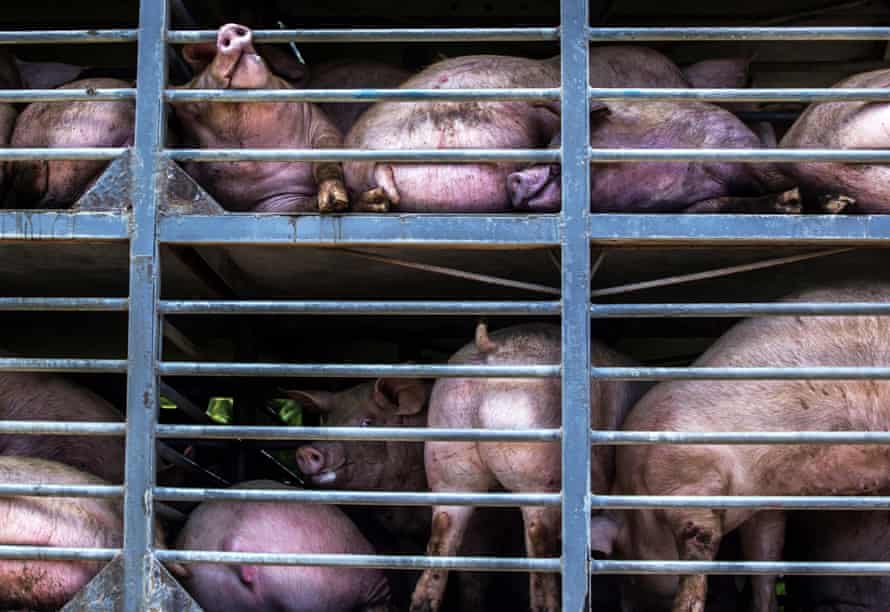How Many Animals Die Every Day In The United States
Tens of millions of farm animals in the US are dying before they can be slaughtered, according to a Guardian investigation exposing the deadly weather condition under which animals are transported effectually the state.
Approximately 20 million chickens, 330,000 pigs and 166,000 cattle are expressionless on arrival, or soon after, at abattoirs in the US every year, analysis of publicly bachelor data shows. A further 800,000 pigs are calculated to be unable to walk on arrival.
Official records of how the animals died are not published, but veterinary and welfare specialists told the Guardian the main causes were likely to exist heat stress, especially during the summer months, and freezing temperatures and trauma.
The numbers of deaths were likely to take been increased past the long distances some animals are forced to travel and the ascent frequency of transporting them.
A truck carrying pigs was tracked while it travelled for 32 hours nonstop beyond the US in August final yr, with the animals kept within for the whole journeying.

Even longer journeys accept been reported for animals being transported beyond the border to or from Mexico and Canada. One trucker told an beast welfare investigator he had driven cattle from the Canadian city of Quebec to Mexico, a journey of almost two days.
Some other trucker said he had brought cattle from a pocket-size stockyard on the due east side of New York to Chihuahua in Mexico, which took 48 hours. The cattle had no water, food or remainder during the journeying.
But one piece of legislation governs U.s.a. beast transport: the 28-hour law, which was first enacted in 1873. The law states that animals must exist unloaded, rested for five hours and given food and water if the journey is longer than 28 hours. It does non encompass birds.
Piper Hoffman, a legal director for the NGO Animal Outlook, said the law was originally designed to cover animals transported by runway. "Information technology was simply in 2006, in response to pressure from NGOs, that the Us government acknowledged the law also protects animals transported by truck," she said.
Despite animal send investigations by Beast Outlook in 2005, 2012 and 2021 – all of which documented what the NGO alleged were violations of the law – no prosecutions have taken place to date.
In Europe, transporting animals by road is theoretically express to eight or nine hours, but exceptions and implementation failures mean some journeys are far longer.
The Guardian'southward transport-related mortality figures for chickens were calculated by converting US Department of Agriculture (USDA) data showing the weight of poultry meat condemned before slaughter.
The number of pigs is based on USDA'due south 2021 slaughter figures and an analysis that found, during the years 2012 to 2015, an average of 0.26% of pigs died after ship, while 0.63% were unable to walk. The cattle figure is similarly based on USDA slaughter figures and an analysis that found an average of 0.49% of cattle were condemned after transport betwixt 2003 and 2007.

A USDA statistician who reviewed the Guardian'southward assay had no corrections to make to the final figures.
Gwendolen Reyes-Illg, a veterinary who works with Animate being Welfare Institute (AWI), a United states of america non-profit, said inquiry indicates the main causes of expiry in cattle were "heatstroke, trauma and respiratory disease … [and in] pigs, the main reason is hyperthermia (overheating), peculiarly during summer".
Additional risks included injuries from slipping in urine and manure, exhaustion, hunger and thirst, said Hoffman.
Dena Jones, a director at AWI, said consolidation in the meat sector with larger and fewer businesses was increasing the distances animals were having to travel to slaughter. An increasing separation between the different stages of production meant animals were as well moved, for case, from growing areas to fattening areas then to slaughter.
Jones said violations of the 28-hour police were probable to be common, "perhaps affecting ten% or more than of farm animals transported between states".
Responding to accusations that it has failed to properly enforce creature welfare regulations, a USDA spokesperson said in an electronic mail: "The [US] attorney general is authorised to seek civil penalties against whatever transporter that knowingly and wilfully violates the 28-hr police. Therefore, any further inquiries about applicability of the 28-hr rule should be directed to the Section of Justice." The US Department of Justice did not respond to questions.
The USDA did not respond to requests for annotate on the number of transport-related animal deaths, nor did the agricultural representative groups the National Pork Producers Council and the American Farm Bureau Federation.
Sign up for the Animals Farmed monthly update to get a roundup of the biggest farming and food stories beyond the earth and keep up with our investigations. You can send usa your stories and thoughts at animalsfarmed@theguardian.com
Source: https://www.theguardian.com/environment/2022/jun/15/more-than-20-million-farm-animals-die-on-way-to-abattoir-in-us-every-year
Posted by: partainovertutremew.blogspot.com

0 Response to "How Many Animals Die Every Day In The United States"
Post a Comment